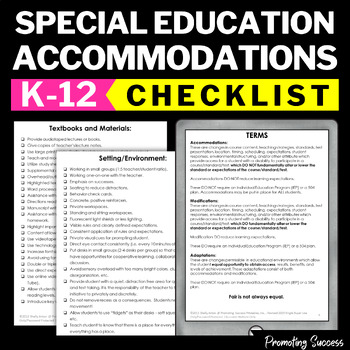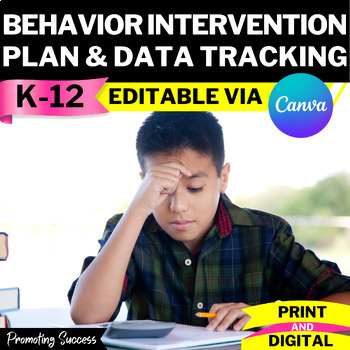Accommodations Checklist for IEP Students, Students with a 504 Plan, or Students Needing Some Extra Assistance to Ensure Success
At this point in the school year, you have no doubt identified some struggling students. 🧐
Some of those students may have an IEP, some may have a 504 Plan, and some may just be struggling in a few areas.
As I am sure you know, there are laws to protect students and their right to a free and appropriate public education.
The Individuals with Disabilities Education Act (IDEA) is a law that makes available a free appropriate public education to eligible children with disabilities throughout the nation and ensures special education and related services to those children.
The Rehabilitation Act of 1973, Section 504 addresses protections for students with disabilities. Section 504 is a federal law designed to protect the rights of individuals with disabilities in programs and activities that receive Federal financial assistance from the department. OCR enforces section 504 in public elementary and secondary schools.
These laws help us understand that free isn't always equal; however, this information doesn't really help you help the students sitting right in front of you.
I spent pretty much my entire career teaching students with special education needs. I taught preschool, junior high (most at 3-5th grade level), high school, and even alternative education (hardest and most loved position). I was also a special education director for a few years. Even with that being said, I'm no expert. Every student is different, so what works with one student may not work with another. However, there are several best practices in terms of accommodations and modifications. It is also super important for students to be taught HOW to implement the accommodations, to have observable data in order to monitor progress, and to always have ongoing evaluation of each accommodation implemented. Also, don't do too many at once because how will you know which one is working?
Accommodations are adjustments made to the learning environment or instructional methods to help students with disabilities have equal access to educational opportunities. These accommodations are required by law under Section 504 of the Rehabilitation Act of 1973, which prohibits discrimination against people with disabilities in programs and activities that receive federal funding. Here are some possible Section 504 accommodations:
Here is a list of accommodations to implement with your students if needed:
1. Visual aids: Using visual aids such as diagrams, pictures, videos, and graphs can help students better understand complex concepts and retain information.
2. Technology: Technology can be a great tool for students with different learning needs. For example, students with reading difficulties can use text-to-speech software or audiobooks, while students with fine motor difficulties can use speech-to-text software or a keyboard.
3. Differentiated instruction: Teachers can use differentiated instruction by providing different ways for students to access the material, such as offering alternative texts or providing hands-on activities. This approach allows students to learn in a way that is best suited to their individual needs.
4. Collaborative learning: Collaborative learning involves working in small groups or pairs. This approach can help students who may struggle with individual tasks but thrive in a more social environment.
5. Flexible seating: Flexible seating allows students to choose where they sit and how they sit. This approach can help students who may have difficulty sitting still for long periods or who may need to move around to focus.
6. Extended time: Allowing students more time to complete assignments or tests can help those who need more time to process information and work at their own pace.
7. Simplified language: Using simplified language can help students who struggle with reading comprehension or who are non-native speakers of the language.
8. Multi-modal instruction: Incorporating multiple modes of instruction, such as visual, auditory, and kinesthetic, can help students learn in different ways and retain information better.
9. Manipulatives: Manipulatives are physical objects, such as blocks, counters, or cubes, that students can use to visualize and represent mathematical concepts. Manipulatives can be particularly helpful for students who struggle with abstract concepts.
10. Visual aids: Visual aids, such as charts, graphs, and diagrams, can help students better understand math concepts and procedures by providing a visual representation of the information.
11. Accommodations for language barriers: For students whose first language is not English, accommodations such as translated materials or a bilingual math teacher can help them better understand the material.
12. Modified assignments: Modified assignments that are tailored to students' individual needs can help them better understand and master math concepts.
13. Alternative assessments: Offering alternative forms of assessment, such as oral or written presentations, can provide students with alternative ways to demonstrate their understanding of math concepts.
14. Audio books: Audio books can be used to help students who struggle with reading comprehension or who have difficulty decoding text. By listening to a book while following along with the text, students can improve their reading fluency and comprehension.
15. Graphic organizers: Graphic organizers, such as mind maps or concept maps, can help students organize their thoughts and ideas while reading. These organizers can be particularly helpful for students who struggle with sequencing or recalling information.
16. Highlighters and sticky notes: Using highlighters and sticky notes can help students identify important information while reading and improve their retention of key concepts.
17. Vocabulary support: Providing support for vocabulary can help students who struggle with reading comprehension. This can include providing definitions, context clues, or visuals to help students better understand unfamiliar words.
18. One-on-one instruction: Providing one-on-one instruction can help students who need additional support with reading. This can include working with a reading specialist or tutor.
19. Note-taking assistance: Providing note-taking assistance, such as a note-taking service or a copy of the teacher's notes, can help students with disabilities who have difficulty taking notes during class.
20. Behavioral support: Providing behavioral support, such as a behavior plan or a sensory-friendly environment, can help students with disabilities who struggle with behavior or sensory issues.
It's important to note that accommodations should be based on individual needs and strengths, and should be used in conjunction with evidence-based instructional practices. They should also be determined through a collaborative process involving the student, parent/guardian, and school staff. By using accommodations, you can help struggling students have equal access to educational opportunities and achieve success in school.
If you want to see my complete checklist of 175 accommodations, please CLICK HERE to see it in my store. This resource has received excellent reviews from all grade levels from early childhood to 12+ and adult education! I find this completely amazing and overwhelmed by the number of students that hopefully achieved success as a result.
Here is what teachers like you had to say about this accommodations checklist:
★★★★★ "So comprehensive and helpful when thinking of the types of accommodations and modifications I can use with my students! Helps tremendously with IEP's as well!!"
★★★★★ "No frills, no cutesy font but I don't need that on this form. A wonderful straightforward easy to read and understand list of accommodations & modifications. Great tool to have when creating an IEP or discussing what a general education teachers can do for a students success."
★★★★★ "This is an excellent source - Full of ideas that I use everyday. Thank you!"
You may also like this Section 504 template mainly used for upper elementary grades and higher, please CLICK HERE.
★★★★★ "This is an excellent tool that I will use for years to come. You can use it generally for grading, or for special students who need accommodations. It is full of invaluable materials!"
★★★★★ "Great resource for documentation."
★★★★★ "Thanks for organizing these sheets for immediate use. I used these for my student teaching."
Please feel free to message me with any requests or comments.
Thank you so much!
❤️ Shelly Anton
Promoting Success for You and Your Students!
https://www.teacherspayteachers.com/Store/Promoting-Success






No comments:
Post a Comment
Please leave a comment below. Thank you!